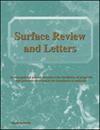ag31po4 / mos2复合光催化剂的制备及其光催化性能
IF 1.2
4区 材料科学
Q4 CHEMISTRY, PHYSICAL
引用次数: 0
摘要
采用水热法合成了ag3po4和MoS 2半导体材料。采用x射线衍射(XRD)、扫描电镜(SEM)、x射线能谱(EDS)和紫外-可见漫反射光谱(UV-vis DRS)对复合材料进行了表征,并对罗丹明B光催化降解有机染料进行了研究。结果表明:以MoS 2微球为基体,在其表面包覆或嵌入纳米Ag 3po 4片层结构,形成了Ag 3po 4 /MoS 2复合光催化剂。当复合产物中Ag 3po 4的摩尔分数为75%时,复合光催化剂具有较好的光吸收能力和较低的光生载流子复合率(光学带隙为1.24 eV),并且在光催化降解RhB实验中表现出较好的可见光光催化降解活性,催化降解率高达95.0%。同时,降解机理表明,H[式:见文]和O[式:见文]是RhB降解的主要活性物质。该光催化剂性能优异,制备方法简单。在光催化领域具有广阔的应用前景。本文章由计算机程序翻译,如有差异,请以英文原文为准。
PREPARATION AND PHOTOCATALYTIC PERFORMANCE OF AG31PO4/MOS2 COMPOSITE PHOTOCATALYST
Ag 3 PO 4 and MoS 2 semiconductor materials were synthesized by hydrothermal method. The composite materials were characterized by X-ray diffraction (XRD), scanning electron microscopy (SEM), X-ray energy dispersive spectroscopy (EDS), and UV–vis diffuse reflectance spectroscopy (UV–VIS DRS), and the photocatalytic degradation of organic dyes by rhodamine B was studied. The results showed that: Ag 3 PO 4 /MoS 2 composite photocatalyst is formed by using MoS 2 microspheres as the matrix and Ag 3 PO 4 nanoparticles coated on its surface or embedded in its lamellar structure. When the molar fraction of Ag 3 PO 4 in the composite product is 75%, the composite photocatalyst has better light absorption capacity and lower photogenerated carrier recombination rate (optical band gap is 1.24 eV), and shows better visible light photocatalytic degradation activity in the photocatalytic degradation of RhB experiment, the catalytic degradation rate is as high as 95.0%. At the same time, the degradation mechanism showed that H[Formula: see text] and O [Formula: see text] were the main active substances for RhB degradation. The photocatalyst has excellent performance and simple preparation method. It has broad application prospects in the field of photocatalysis.
求助全文
通过发布文献求助,成功后即可免费获取论文全文。
去求助
来源期刊

Surface Review and Letters
工程技术-物理:凝聚态物理
CiteScore
2.20
自引率
9.10%
发文量
139
审稿时长
4.2 months
期刊介绍:
This international journal is devoted to the elucidation of properties and processes that occur at the boundaries of materials. The scope of the journal covers a broad range of topics in experimental and theoretical studies of surfaces and interfaces. Both the physical and chemical properties are covered. The journal also places emphasis on emerging areas of cross-disciplinary research where new phenomena occur due to the presence of a surface or an interface. Representative areas include surface and interface structures; their electronic, magnetic and optical properties; dynamics and energetics; chemical reactions at surfaces; phase transitions, reconstruction, roughening and melting; defects, nucleation and growth; and new surface and interface characterization techniques.
 求助内容:
求助内容: 应助结果提醒方式:
应助结果提醒方式:


